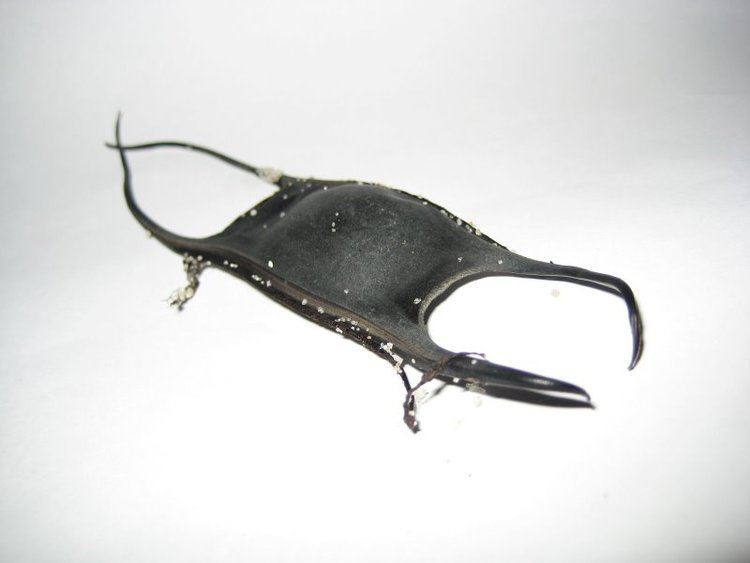 | ||
An egg case or egg capsule, colloquially known as a mermaid's purse or devil's purse, is a casing that surrounds the fertilized eggs of some sharks, skates, and chimaeras. They are made of collagen protein strands.
Contents
- Sharks
- Bullhead sharks
- Carpet sharks
- Ground sharks
- Skates
- Big skates
- Other skate species
- Applications
- Chimaeras
- References
Because they are lightweight, they are commonly washed up by the sea, often found at the strandline, the farthest point of the high tide. The egg cases that wash up on beaches are usually empty, the young fish having already hatched out. Furthermore, egg cases are often found in commercial fishing gears like nets and pots, and on the sea floor during surveys using an ROV.
Sharks
Among the 9 extant orders of sharks, egg-laying is found only in three:
Bullhead sharks
The egg cases of bullhead sharks (Heterodontidae) have spiral flanges that allow them to be wedged inside crevices or into sand.
Carpet sharks
The bamboo sharks (Hemiscylliidae) and the zebra shark (Stegostomatidae) lay eggs on the bottom, while the other carpet sharks give live birth. The egg cases are oval and covered with adhesive fibers that serve to secure them to the bottom.
Ground sharks
Some catsharks (Scyliorhinidae) and the finback catsharks in the genus Proscyllium are the only members of their order that lay eggs. The egg cases of catsharks are purse-shaped with long tendrils at the corners that serve to anchor them to structures on the sea floor.
The size of egg cases vary; those of the small-spotted catshark or lesser spotted dogfish, Scyliorhinus canicula, are around 5 centimetres (2 in) long, while those of the greater spotted dogfish, S. stellaris, are around 10 centimetres (4 in). That excludes the four long tendrils found in each corner, which assist in anchorage. Egg cases from rays vary in that they have points rather than tendrils. The colours and shapes of egg cases also vary greatly from species to species.
Egg cases are deposited in pairs on the sea floor, and hatchlings are believed to emerge within 9 months. Gestation can take longer, up to 12 months or more for deep sea catsharks which lay their eggs in very cold water. If an egg case is still moist (not dried out) and has no visible hole, it is probably still occupied.
Skates
The skates (Rajidae, Arhynchobatidae, Anacanthobatidae) are the only rays that are oviparous. Females lay egg cases onto the sea floor after fertilization occurs in utero. While in utero, a protected case forms around the embryo which is called the egg case. Studies have been done where egg cases were removed from gravid females to ensure proper identification in regard to skate species. Egg cases have distinguishable characteristic traits that are unique to that species, thus making it a great tool for identifying a skate. The two most distinguishable features on the egg case are the keel and the absence or presence of a fibrous covering. A keel runs laterally along both sides of the outer edge of the egg case; it is a flexible structure. Keels will also run the length of the horns on some skate species. Some egg cases have broad keels (greater than 10% of the maximum egg case width) while others have narrow keels (less than 10% of the maximum egg case width). Many egg cases are covered with a layer of fiber; some will have a fine layer while others have a thick layer.
Big skates
The big skate is known to be the largest skate in the eastern North Pacific Ocean. Their maximum size has been noted as 244 cm total length (TL), but the largest confirmed size is 203.9 cm TL.
Other skate species
The longnose skate, Raja rhina, is considered a larger skate species; reaching a maximum size range of 145 cm TL. Although their egg cases are smaller than that of the big skate, their cases are considered large too; ranging 93–102 mm in length.
The roughtail skate, Bathyraja trachura, is a medium-size skate, with a maximum size of 91 cm TL.
Applications
Relevance of knowing skate egg case identification features and size:
Chimaeras
The egg cases of chimaeras are spindle- or bottle-shaped with fins on the sides. They are laid on the bottom.
